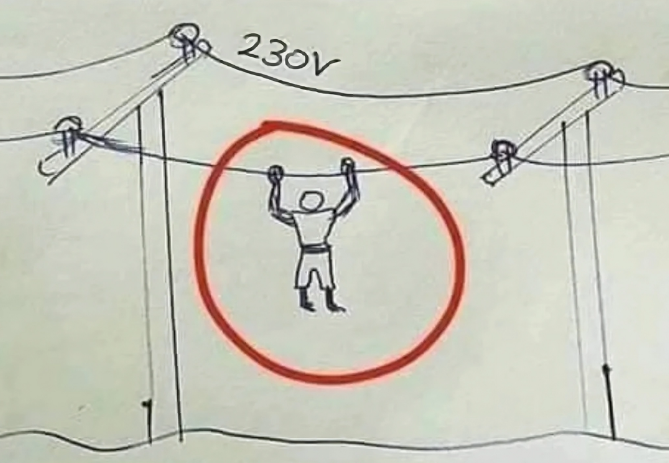Have you ever wondered if you could get shocked by grabbing onto a live electrical wire? This question might sound daring, but it sheds light on some fascinating physics principles. If you’ve ever seen birds perched comfortably on power lines, you might wonder why they aren’t electrocuted and if the same would apply to a human. So, let’s dive into this intriguing question: if a person hangs from a live wire with both hands, will they get shocked?

How Electricity Works: The Basics
To understand why someone hanging from a live wire might not get shocked, it’s essential to grasp a few basics about electricity. For electricity to flow, it needs a closed circuit. This means it requires a pathway to move from a power source, through a conductor, and back to the ground (or another point in the circuit). Without a return path, the electric current doesn’t flow through you—it stays within the wire itself.
In simpler terms, electricity flows only when it has somewhere to go. Birds, for instance, can sit on power lines because they aren’t providing an additional path for the electricity to travel. The current remains in the wire, and the bird stays safe.
Why Birds Don’t Get Shocked on Power Lines
When birds sit on power lines, they have no connection to another line or the ground. With no circuit to complete, the electricity doesn’t travel through the bird’s body. In the same way, if a person grabs onto a single live wire without touching the ground or any other conductive material, the current won’t flow through their body, making it possible for them not to get shocked—at least in theory.
The concept of a completed circuit is vital here. Electricity flows along the path of least resistance. As long as you don’t provide a path for the current to reach the ground or another point, the electricity won’t “see” a reason to flow through you.
So, Could a Person Hang from a Live Wire Safely?
In theory, yes, a person could hold onto a live wire without getting shocked as long as they aren’t in contact with the ground or any other conductive surface. Like the bird, the person wouldn’t provide a path for the electricity to flow through. However, the situation can turn deadly if any other contact point—such as the ground, a tree, or even another wire—is touched. The instant that second point of contact is made, a circuit is completed, allowing electricity to flow, which can lead to a severe electric shock or even death.
This principle is why linemen who work on power lines use specialized equipment, insulating gloves, and sometimes even helicopters to prevent any contact with the ground. They isolate themselves from completing any circuit, thus allowing them to work safely around high-voltage wires.
Factors That Could Make This Dangerous
While it might sound possible to hang from a live wire without getting hurt, attempting this in real life would be extremely dangerous. Here are a few reasons why:
- Unpredictable Contact Points: You may unintentionally brush against another wire or object that can complete the circuit.
- Voltage and Current Strength: Even if no path to the ground is created, high-voltage wires can still produce electric fields strong enough to induce a current in a nearby conductor, including a human body. This induced current can lead to dangerous levels of electricity flowing through you.
- Humidity and Moisture: If there is any moisture in the air or on your skin, it can create an unintended pathway for electricity, putting you at serious risk.
- Electric Fields: Higher voltage lines create larger electric fields that can sometimes induce a current even without direct contact with a secondary surface. This phenomenon is rare but possible with high enough voltages.

Electricity and the Human Body: Why a Second Point of Contact is Fatal
If you’re holding onto a live wire, touching another object—especially a grounded object like the earth—creates a “bridge” for the electricity. Suddenly, you’ve provided an alternate path, and the electricity flows through your body on its way to the ground. Since the human body is mostly water and conducts electricity well, this can cause severe damage to internal organs, nerve pathways, and muscles, often resulting in fatal injuries.
This concept is why electricians and other professionals who work with live wires use insulated gloves, rubber boots, and other safety equipment designed to prevent creating an electrical path to the ground. These tools add layers of resistance, stopping electricity from flowing through the body even if accidental contact with a second surface occurs.
The Risks and Dangers of Electric Shock
Electric shocks are no minor matter. Even relatively low voltages can cause severe injuries, and high-voltage lines carry life-threatening amounts of power. Electric shock injuries can cause:
- Burns: Severe burns where the electricity enters and exits the body
- Cardiac Arrest: Disruption of the heart’s normal rhythm
- Nerve Damage: Injuries to nerves can cause paralysis or chronic pain
- Muscle Damage: Severe shocks can cause muscles to contract powerfully, leading to fractures and muscle damage
Even in non-lethal doses, electric shock can leave lasting damage. This is why experts advise extreme caution around any live electrical source.

Why You Should Never Try This
Though theoretically, it may sound safe to hang from a single wire, it’s impossible to control all the variables. Even if you avoid touching anything else, factors like moisture, proximity to other objects, or the strength of the electric field can change the outcome. Electric shock accidents are often sudden and severe, leaving no room for a second chance.
In addition to high-voltage wires, even lower voltage household wires can pose significant dangers. It only takes a small amount of electric current to disrupt a person’s heartbeat, and household wiring can deliver a powerful shock. Safety should always be a priority, and the potential for harm is simply too great to take such a risk.
The Bottom Line: Why Electricity Isn’t Something to Test
In summary, while holding onto a live wire without touching anything else may theoretically avoid an electric shock, it’s a dangerous misconception to think it’s safe to do so. Electricity needs a complete circuit to flow, but creating that circuit can be as simple as an accidental touch. Just like birds, humans can avoid electric shock if they avoid completing the circuit—but unlike birds, we don’t belong on live wires.
Remember, electricity is unpredictable and immensely powerful, and it only takes a minor mistake to turn a theory into a dangerous situation. Stay safe, avoid contact with live wires, and always call professionals for any electrical concerns.


